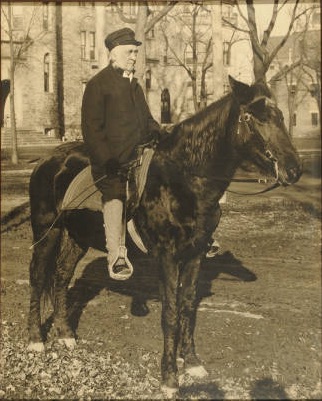Oberlin College Archives Celebrates Half-Centennial Anniversary

Photo courtesy of the Oberlin College Archives
A photograph of James Harris Fairchild (1817 – 1902) taken in Tappan Square. Artifacts like this are being displayed by the Oberlin College Archives in Mudd library.
October 7, 2016
The Oberlin College Archives has been a resource for students, faculty, residents and the global research community since its establishment 50 years ago this week. To celebrate the anniversary, Archives staff members have put together an exhibit that will be on display in Mudd library until Oct. 21. The exhibit includes photographs, documents and other items connected to Oberlin College and Conservatory history, as well as to the lives of notable alumni such as Mary Church Terrell, OC 1884, a Black women’s rights advocate and Oberlin alumna who obtained a graduate degree in 1888, one of the first African- American women to do so, and Carl Rowan, OC ’47, who was involved in the Civil Rights Movement. Several staff favorites are also on display — many drawn from under-utilized collections. The Archives will host a celebratory open house Saturday, Oct. 8 from 10 a.m.–2 p.m. in the Goodrich Room on the fourth floor of Mudd library.
“We wanted to give people an opportunity to come and see what we have here,” College Archivist Ken Grossi said. “It was actually a hard thing to do, to choose, but it gives the current staff a chance to make a favorite selection or two from the collection.”
Grossi himself chose a photograph of James H. Fairchild, the third president of Oberlin College. Fairchild, who was 82 at the time the photo was taken, is shown astride a horse in Tappan Square. Behind him to the west of Tappan are two now-demolished buildings, Warner and Cabinet Halls. Cabinet used to house the College’s natural history specimens and its early chemistry department. Warner was the original Conservatory building, which stood on the corner of West College Street and North Professor Street that the King Memorial Building now occupies.
Louisa Hoffman, the archival assistant, chose a painted copper shingle. “It’s from a replica temple at the Chicago Expo in 1932 during the wave of Orientalist interest,” Hoffman said. The temple was a well-traveled copy of the Golden Pavilion of Jehol in Manchuria and made an appearance in Oberlin in the early 1940s. Indiana University entrusted the pavilion to a group that had plans to restore it but lacked the funds to do so, and the restoration plans were abandoned as a result. Rescued from a scrap metal dealer’s storage unit by Indiana University in the 1990s, the pavilion made its way to first Harvard University and then Sweden.
Grossi also picked several artifacts from the life and career of anthropologist Eduardo Mondlane, OC ’53, the first president of the Mozambican Liberation Front. The Mondlane collection, which includes a 1953 photograph of his Oberlin graduation, is one recent example of the kind of draw the Archives generate in the wider research community. Just this spring Livio Sansone, an associate professor of Anthropology at the Federal University of Bahia in Brazil, came to Oberlin to speak about Mondlane and to use Oberlin’s collection of related information for a project for the Digital Museum of African and Afro-Brazilian Heritage.
Outside researchers and institutions are especially attracted to the collection on the King- Crane Commission, a government investigation in Turkey and the Middle East involving Henry Churchill King, the sixth president of the College. Researchers also come to see items from the the Shansi Collection and from collections on topics such as abolitionist efforts.
The exhibit also showcases a piece on the importance of student involvement in the Archives, highlighting their contributions with a poster featuring past and present student staff workers. Students have long been an integral part of the Archives, and faculty often incorporate the archives into classes, especially in the social sciences.
“We have pretty good exposure in our support of the educational front,” Grossi said. He also cited the Archives’ blog, which provides updates and promotes events to a growing number of followers, as evidence of increased interest in an important campus and community space. The exhibit and open house provide opportunities to increase awareness of the kinds of resources the Archives has to offer, as well as show off staff favorites rarely on display.
























